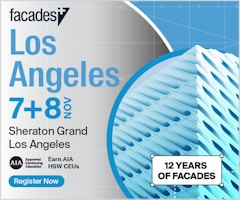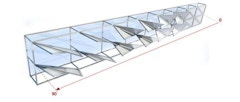
230 results
-
 Kinetic responsive systems are gaining attention in architectural applications, to reduce the building’s energy consumption and environmental impact,…
Kinetic responsive systems are gaining attention in architectural applications, to reduce the building’s energy consumption and environmental impact,… -

Specifying Commercial Aluminum Finishes
- Paper by Ben Mitchell, MBA,
Many factors will influence coating selection, but to achieve the desired performance level for a given situation, coatings must be specified based… -

Heat-actuated Auxetic Facades
- Paper by Amira Abdel-Rahman · Elnaz Tafrihi
Highly transformable materials can be used as adaptive exterior shading systems by leveraging the relationship between external stimuli (heat) and
-
Kinetic Shading Systems
- Paper by Alireza Jahanara · Negar Kalantar
This study focuses on experiments in kinetics and architectural skins. More extensively, it introduces a solution for environmental design issues and
-
Emulating Nature's Structured Randomness in Facade Design
- Paper by Ned S. Kirschbaum FAIA, CCCA, LEED AP BD+C
The wonder of nature is the abundance of unique forms she creates based on a few simple physical principles or laws. No two snowflakes are alike.
-

Coupling Facade and Structure
- Paper by Trevor Stephen Lewis, PhD, PE · Jessica Chen, PE
Traditional approach for engineering the facade is building an isolated analysis model. However, it inhibits a dynamic design process where
-

Performance Based Generative Facade Workflow for Large Scale Projects
- Paper by Paul Ferrer · Mili Kyropoulou · Tim Logan · Heath May · James Warton
Over the last two decades, in what has been coined “The Digital Turn”, the introduction of parametric design software has afforded increased
-
BioFacades Classification
- Paper by Mary Ben Bonham, Kyoung Hee Kim, Professor, Director of IDRL | Founder of EcoClosure Christiane M. Herr, Professor at the School of Design, Southern University of Science and Technology, Shenzhen
Coauthors: Mary Ben Bonham, Department of Architecture + Interior Design, Miami University, Oxford, OH, USA [corresponding] [presenting at the… -
RECAP – CTBUH 2015 Host Room Assembles World-Class Lineup of Building Facade Specialists
On October 26th and 27th, the Facade Tectonics Institute assembled a world-class lineup of building facade specialists at the CTBUH 2015 International Conference in New York City.
-
Facade Tectonics Room at CTBUH 2015 International Conference Assembles World-Class Lineup of Building Facade Specialists
- Press Release
On October 26th and 27th, the Facade Tectonics Institute assembled a world-class lineup of building facade specialists at the CTBUH 2015 International Conference in New York City. The host room, titled Skinning the Tall Building: Framing the Future of Building Facade Technology, featured a series of
-

Event Passed
–Net Zero 2023 Conference
- Los Angeles, USA
Don't just wait for the future, build it. NZ23, the world's largest net zero conference, is building a #NetZeroFuture for all. Learn more & register at www.NetZeroConference.com
Industry Event by Verdical Group
-

-

MODESTEhouseTEST: August 7-17, 2017
- Article by W. Geoff Gjertson, Architect, AIA, Professor of Architecture and Co-Director of the Building Institute
A design-build class at the University of Louisiana explores the territory of the “tiny-house.” Professor Geoff Gjertson describes the 216 square foot MODESTEhouse and shares his personal experience of living small.
-

High Performance: Who Benefits?
- Article by Alexandra Blakeslee, Innovation & Projects
I recently started studying Sustainable Environmental Systems at Pratt Institute. One of my classes focused on climate change and its social effects across the world. I started to connect the dots backward and question the impact of our work in facades and fenestration on our local communities.
-
North Capitol Building Case Study
- Paper by Jeremy Simmonds, Project Manager at KEPCO+ Bruce Knaphus, President
The Utah State Capitol North Building, currently under construction, features 80,000 SF of classically designed cubic granite detailing, including… -

-

Facades+ Los Angeles
- Event by The Architect's Newspaper
The Premier Conference for High-Performance Building Enclosures brings the AEC Community together to discuss all things facades, from technical innovations, new materials, and designs that push the envelope. Be inspired by presentations and discussion by world-class architects and engineers.
-

BAU 2021 ON-LINE
- Event by Messe München
BAU is the World's Leading Trade Fair for Architecture, Materials and Systems. It has proven itself as an efficient international contact and business platform for the construction industry.
-

Historical Evolution of Responsive Facades
- Paper by Negar Heidari Matin, Ph.D. Candidate, LEED GA, Ali Eydgahi, Ph.D., Shimming Shyu, Ph.D., RA, LEED AP BD+C, Payam H. Matin, Ph.D.,
Responsive facade system is considered a major component of high-performance building envelope that is capable of responding to environmental stimuli… -

Happening Now
–Support our Mission - Donate Now!
Support our Mission - Donate Today
Forum by Facade Tectonics Institute, Inc.

